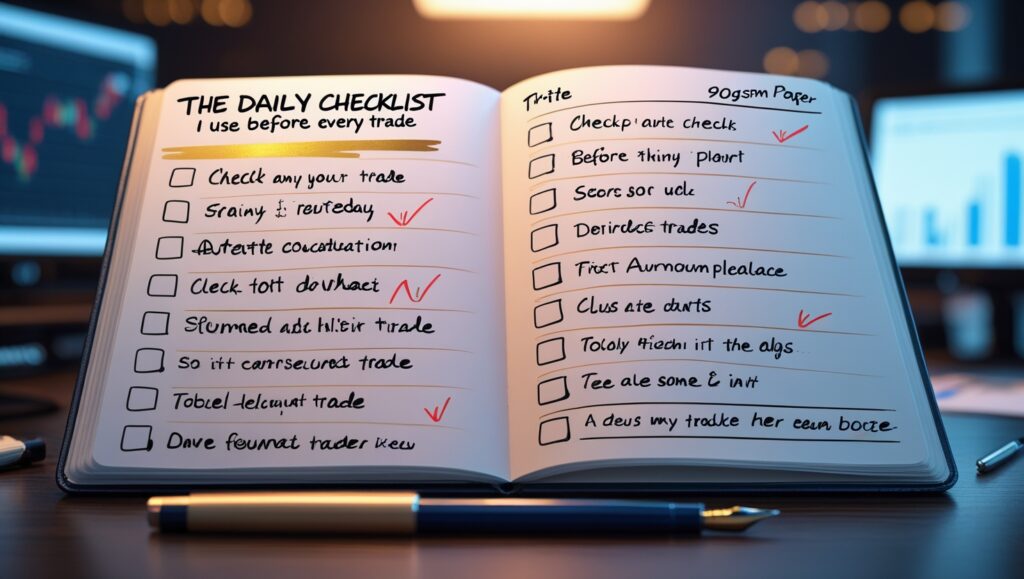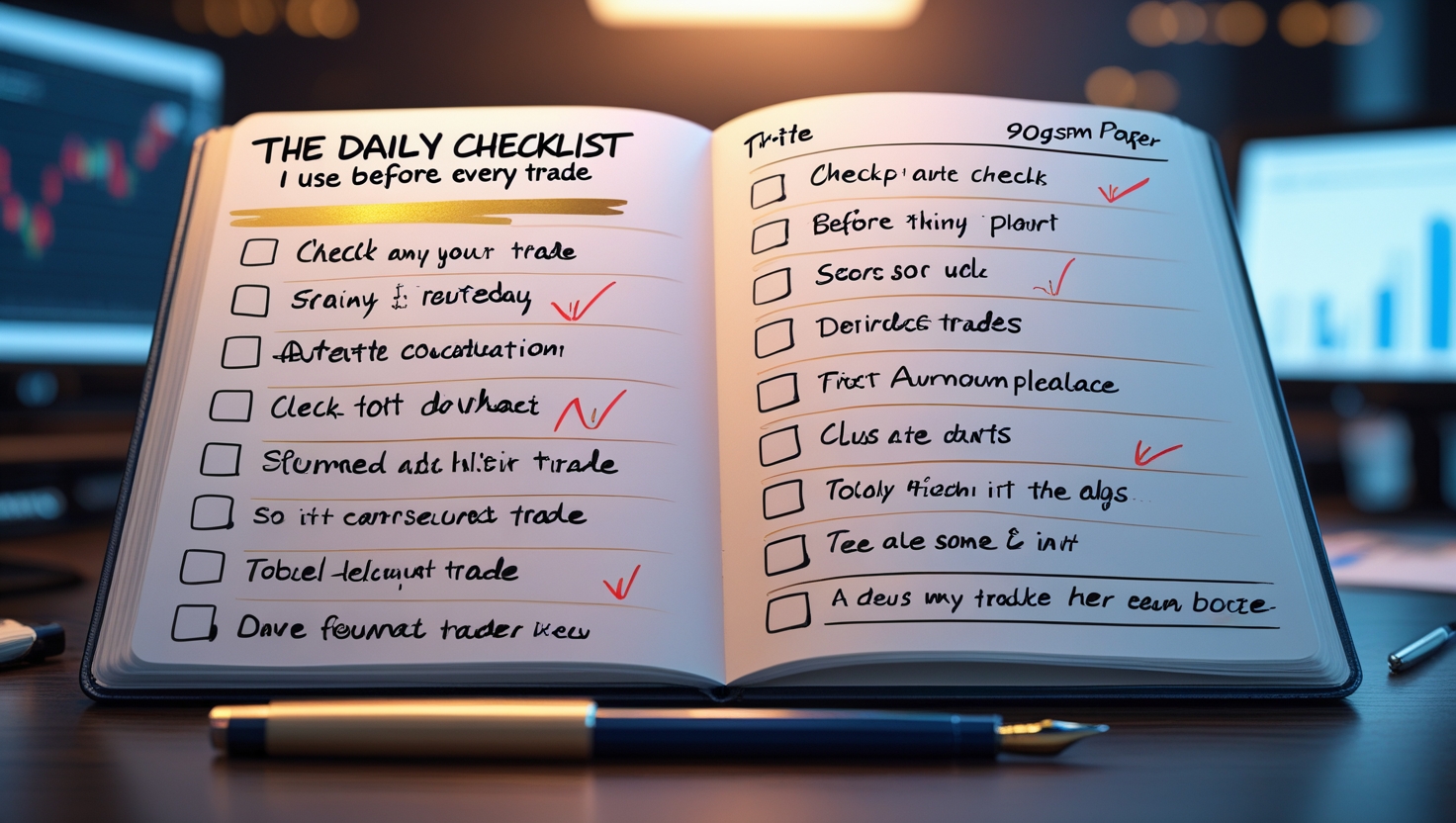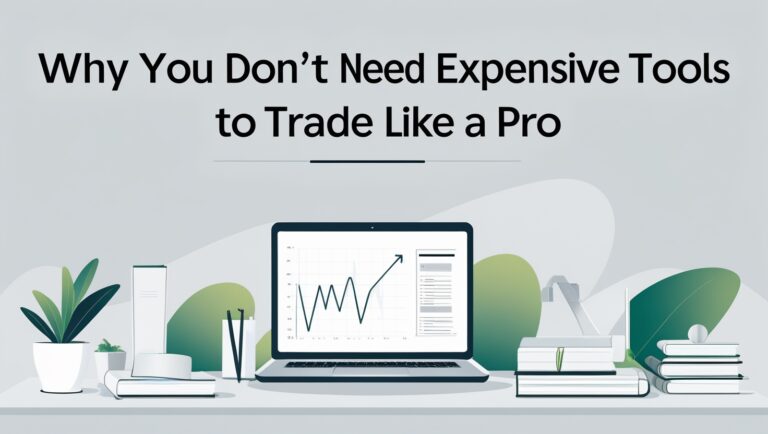The Daily Checklist I Use Before Every Trade
The Daily Checklist I Use Before Every Trade
When I first started trading, I had no structure. I’d open my broker, scan random stocks, jump into trades with no real plan, and then wonder why I was losing money. It wasn’t until I created a simple, repeatable checklist that everything changed.
Now, before I take any trade, I go through the same daily trading checklist — and it’s the reason I’ve been able to grow my account and pay my bills month after month.

Table of Contents
Why a Checklist Matters in Stock Trading
Trading isn’t just about strategy — it’s about discipline. And when you have a trading checklist, you eliminate emotional decisions. You stay focused, you avoid bad setups, and you make moves based on logic — not feelings.
This is especially important if you have a small account, a full-time job, or limited screen time. I built my checklist to help me make consistent decisions even when I only have 30–45 minutes in the morning to trade.
My Personal Pre-Trade Checklist
Here’s exactly what I do every morning before entering a trade:
- Check market sentiment. I always look at SPY and QQQ to get a feel for the overall direction. If the market’s choppy, I adjust my expectations.
- Scan for gappers with volume. I use free screeners like Finviz or Market Chameleon to see what’s gapping up with high volume pre-market.
- Narrow down to 5–6 stocks. I never watch more than six. Less noise = more focus.
- Look for a clear catalyst. News, earnings, or sector momentum. If there’s no reason for the stock to move, I pass.
- Draw key levels. I mark premarket highs/lows and areas of support/resistance — that’s all I need. No indicators.
- Check volume and float. I prefer low-to-mid float with strong volume. If it looks like it’ll be slow or thin, I skip it.
- Wait for confirmation. I don’t buy right at the open. I wait for a clean setup — usually a pullback, reclaim, or breakout with strength.
This process takes me about 20 minutes, and it’s how I prep for every trading day.
Why It Works (Even Without Indicators)
I don’t use RSI, MACD, or complicated indicators. Everything I do is based on price action and volume. My checklist is built to keep me objective, grounded, and focused only on high-quality setups.
If I don’t see what I want, I don’t trade. That’s how I protect my capital and stay consistent. And yes — this exact process is what I teach inside my ebook.
What’s Inside My Ebook
In the ebook, I break down how I:
- Use this checklist to pay my bills each month
- Build watchlists that actually make money
- Know when to trade and when to stay out
- Trade with confidence even with a small account
You don’t need a bunch of tools or expensive software. You just need clarity, focus, and a plan that actually works — and that’s what I share inside the guide.
If you’ve been feeling lost or overwhelmed, this checklist is the starting point. I created it for myself when I was stuck, losing trades, and overcomplicating everything. Now, I stick to this routine and it’s made all the difference.
➡️ Grab the full step-by-step system here:
https://stockflowreport.gumroad.com/l/paybillswithstocks
Another key part of my routine is pre-market mindset. Before I even sit at my desk, I check in with myself. If I’m tired, stressed, or distracted, I’ll pass on trading that day. One bad decision can cost me more than just money — it can shake my confidence. That’s why emotional clarity is part of my checklist too.
I also set a maximum loss limit before the bell rings. I decide how much I’m willing to risk that day, and if I hit that number, I stop. No revenge trading. No “just one more.” This helps me avoid digging myself into deep holes — something I used to do a lot as a beginner.
Another habit that changed my results is tracking what the overall market is reacting to. Is it inflation data? Fed meetings? Tech earnings? You don’t have to watch the news all day, but understanding what’s moving the market helps you stay one step ahead.
I also review my top watchlist pick and ask myself: “Would I be proud to take this trade?” If the answer is no — if the setup feels forced or I’m just bored — I cut it. This self-check keeps me aligned with my goals, not my emotions.
Part of my checklist involves checking float rotation and volume at premarket highs. I look for confirmation that others are watching the same levels. If a breakout has no volume behind it, I skip. That patience alone saved me thousands.
After that, I prepare my exit plan in advance. I decide where I want to take profits and where I’ll cut losses. When you plan your exits before you enter, you stay calm — even if the trade goes against you.
I also make sure I’m not distracted by social media alerts or chatroom noise. I trade my plan — not someone else’s. My setup works for me. That’s what I try to emphasize in every post and inside my ebook.
One overlooked part of my checklist is documenting every trade, even the small ones. I keep a simple log with the ticker, my reason for entry, the outcome, and what I learned. This helps me improve over time and spot patterns in my behavior.
I’ve learned that less is more. If I see three setups, I pick one — the best one. Spreading myself thin used to cost me more than I realized. Now, I focus only on the highest-probability plays and skip the rest.
Many people underestimate the power of repetition. This checklist might sound basic, but that’s the point. I do it every day, without fail. The more I repeat it, the more confident and consistent I become.
When I talk to people who are struggling, the first thing I ask is: “Do you have a checklist?” Most say no. That’s the missing piece. Structure creates freedom. Once you have a clear daily process, everything else becomes easier.
That’s why I believe so much in giving people a roadmap. You don’t need to copy me — you need to build a system that makes sense for your life. If my process helps you build that foundation, then my job is done.

Stay ahead in the stock market! Subscribe to our newsletter and receive exclusive stock flow reports, trading insights, and actionable tips directly in your inbox. Join thousands of traders who get our updates first.







